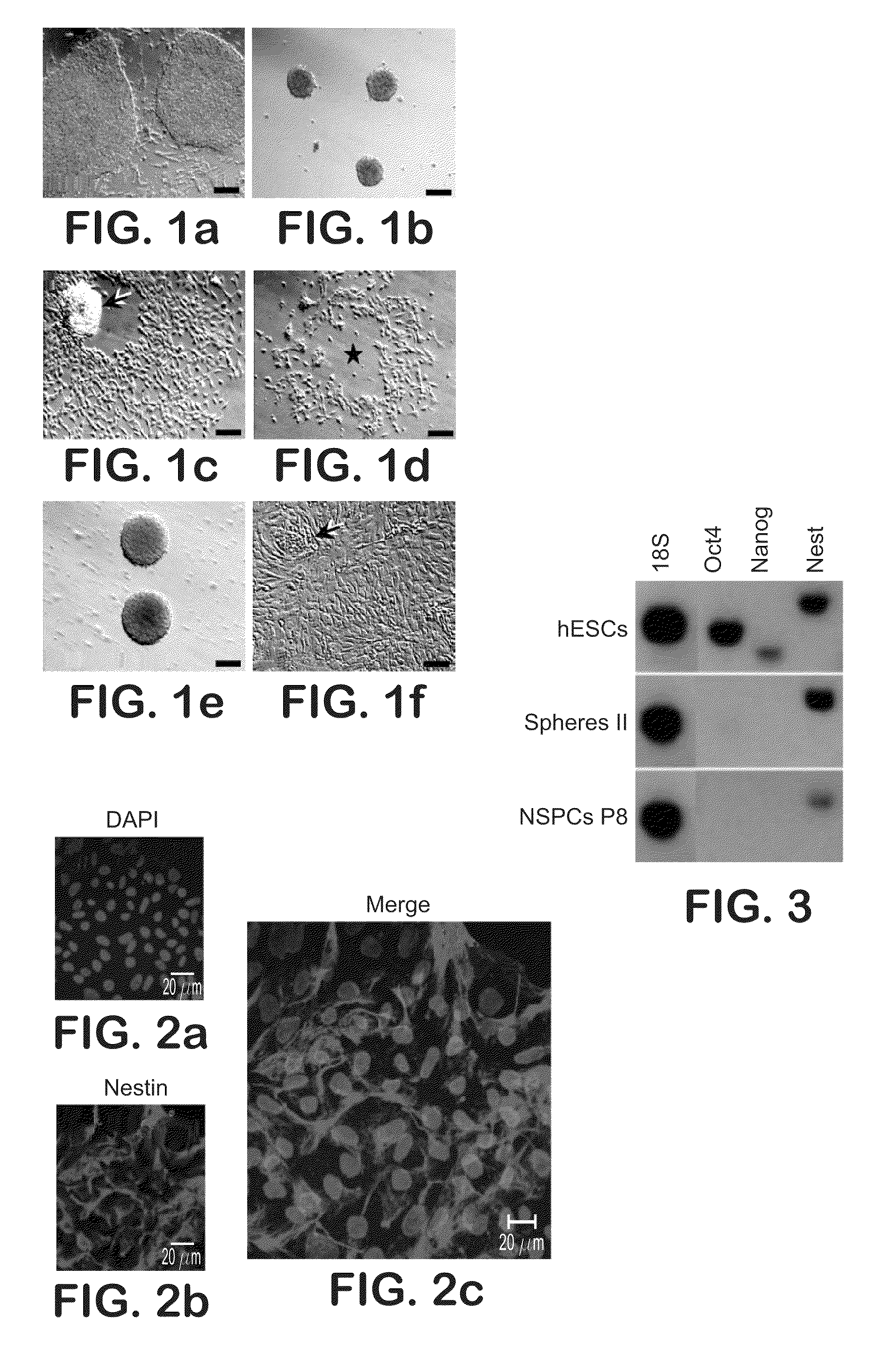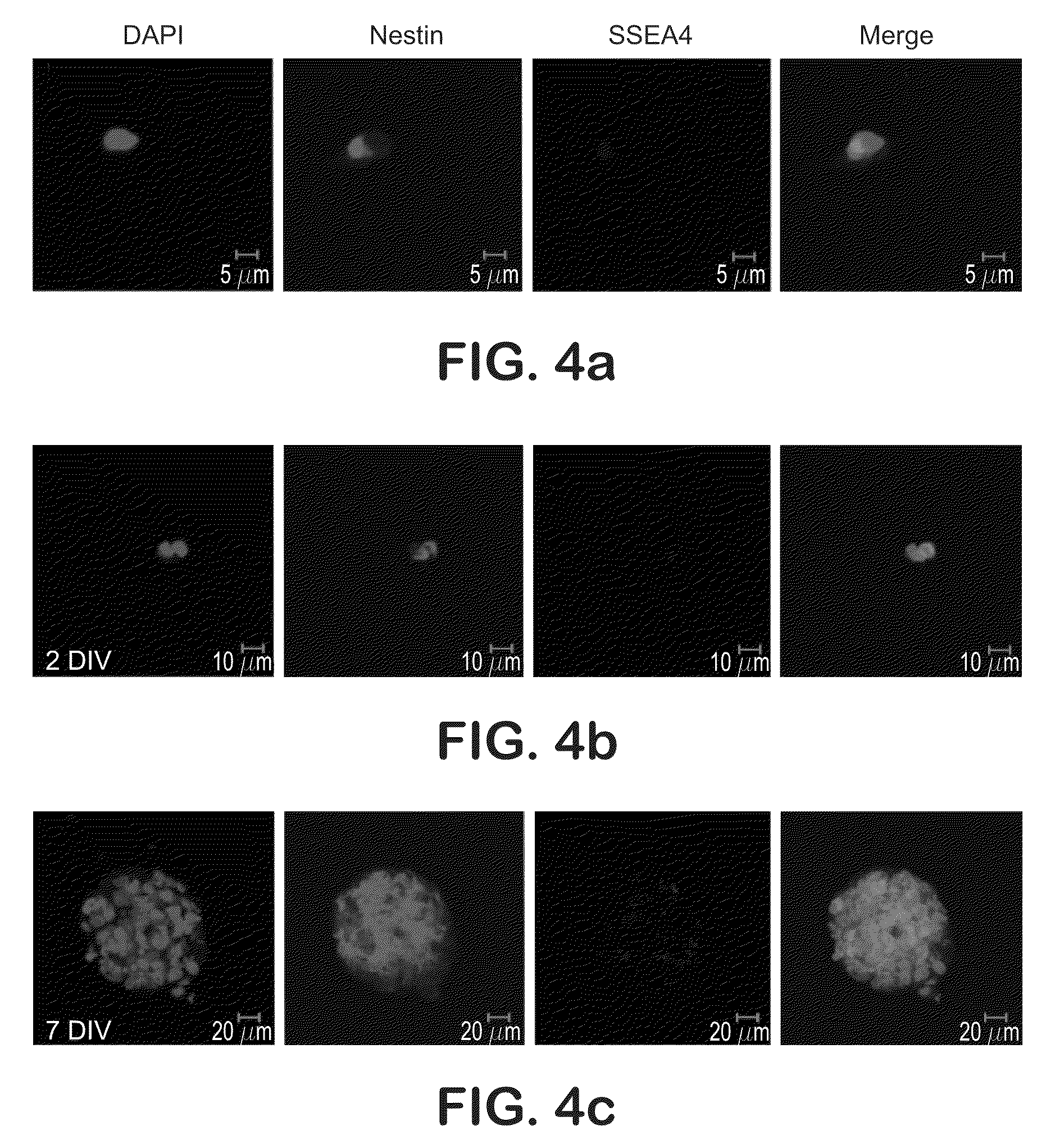Derivation of neural stem cells from embryonic stem cells and methods of use thereof
a neural stem cell and embryonic stem cell technology, applied in the field of neural stem cells from embryonic stem cells, can solve the problem that adult progenitor cells cannot be renewed indefinitely
- Summary
- Abstract
- Description
- Claims
- Application Information
AI Technical Summary
Benefits of technology
Problems solved by technology
Method used
Image
Examples
example 1
Devivation of NSCS From hESCS
[0097]A stable homogeneous population of expandable multipotent NSCs was derived from the NIH-registered WA09 hESC line (“the H9 cell line”). The H9 cell line was expanded according to the supplier's protocol (FIG. 1a). After cell dissociation with collagenase, a portion of the H9 cell line was cultured in serum free media containing 20 ng / mL EGF, 10 ng / mL bFGF, and 10 ng / mL LIF. The defined media consisted of DMEM with F12 supplement (1 / 1) and the defined hormone mixture described above. After 3 days in vitro, the cells appeared aggregated in clusters or spheres in suspension with selective survival and growth (FIG. 1b). The dead cells were eliminated from the culture by selective centrifugation and the healthy spheres (primary spheres) were replated in fresh media with 20 ng / mL EGF, 10 ng / mL bFGF, and 10 ng / mL LIF.
[0098]During the following week, the spheres of clustered cells attached to the flask and a fibroblastic-like cell population began to migra...
example 2
Testing for Self-Renewal of NSCS
[0101]To ascertain self-renewal ability under clonal conditions, the NSCs of Example 1 were single cell dissociated with collagenase and trypsin at passage 4 and greater and were plated at a clonal density of 10 cell / μL. To identify proliferating clones, cultures were fixed after 1, 2, and 7 day culture periods (FIGS. 1i-1k). After 48 hours, plated single cells underwent a first cell division and gave rise to the first progeny expressing nestin, a neuroepithelial stem cell marker. The single cell derived spheres continued to grow over the 7 days in vitro at which time all of the neurospheres generated expressed nestin indicating the neural purity of the isolated precursors. When induced to differentiate, the neurospheres consistently gave rise to neurons, astrocytes, and oligodendrocytes (FIG. 2). Under the culture conditions described herein, no rosette formation was observed during neural induction (c.f., U.S. Pat. No. 6,887,706 to Zhang et al.).
example 3
Differentiation of the NSCS
[0102]NSCs from the fifth and greater trypsin-EDTA passages of Example 1 were spun down and the supernatant was removed; the NSCs were resuspended in fresh media lacking the mitogenic factors and plated at a density of 5×105 cells / mL on poly-L-ornithine (PLO) coated (15 mg / mL; Sigma-Aldrich Corp., St. Louis, Mo.) glass coverslips in a 24 well Nunclon culture dish. Upon plating, the NSCs stopped proliferating and spontaneously differentiated into neurons, astrocytes, and oligodendrocytes consistent with normal neural precursor cell properties (FIGS. 2c-2e). After 2 days in vitro, 47.3±2.8% of the total population were nestin positive; 26.1±1.9% expressed the neuronal marker Tuj1; 30.3±2.1% expressed the astrocyte marker GFAP; and 8.7±0.8% differentiated into galactocerebrocide positive (GC+) oligodendrocytes. After 10 days in vitro, the proportion of nestin-positive cells decreased to 36.6±2.7; 62.5±2.8% expressed the neuronal marker Tuj1; 1.9±0.3% were GFA...
PUM
| Property | Measurement | Unit |
|---|---|---|
| Concentration | aaaaa | aaaaa |
| Concentration | aaaaa | aaaaa |
| Basicity | aaaaa | aaaaa |
Abstract
Description
Claims
Application Information
 Login to View More
Login to View More - R&D
- Intellectual Property
- Life Sciences
- Materials
- Tech Scout
- Unparalleled Data Quality
- Higher Quality Content
- 60% Fewer Hallucinations
Browse by: Latest US Patents, China's latest patents, Technical Efficacy Thesaurus, Application Domain, Technology Topic, Popular Technical Reports.
© 2025 PatSnap. All rights reserved.Legal|Privacy policy|Modern Slavery Act Transparency Statement|Sitemap|About US| Contact US: help@patsnap.com



